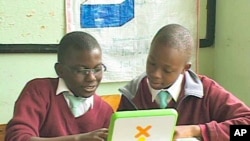The US-based One Laptop Per Child Initiative creates educational opportunities for poor children around the world by providing low-cost, durable portable computers. Seven countries in Africa are already participating in the initiative. One school in Kenya has set up a pilot program to test the computers. Cathy Majtenyi reports for VOA from Nairobi.
They gather around what looks like a bright, plastic green and white notebook.
It is their gateway to a new world of learning and wonder.
Students at Our Lady of Mercy Primary School South B in Kenya's capital have received 16 of these computers from the One Laptop Per Child Initiative.
They have had them since March of this year in a Grade 8 pilot project.
So far so good, says 14-year-old Marvin Oyuke, who says that he has used the laptop for his geography homework. "I learned that Lake Tanganyika is the second deepest [freshwater] lake in the whole world and Lake Victoria is also the second largest [freshwater lake] in the whole world and River Nile is the longest in the world actually and Mount Kilimanjaro is the highest [mountain] in Africa," he said.
The One Laptop Per Child Initiative was launched four years ago by the U.S. non-profit group of the same name.
Seven countries in Africa are already participating in the initiative.
Kenya is not yet on board, but if the test pilot at Our Lady of Mercy School is successful, Kenya could become the first East African country to join the program.
Sister Agnes Kariuki, headmistress of Our Lady of Mercy South B, says that there has been limited use of the computers at her school.
Security is a big issue in Nairobi's South B neighborhood. Sister Kariuki says her school is looking for funds to beef up the building and procedures before the computers can be used on a regular basis. "About three times we have had very serious break-ins and they have interfered with the previous computers that we have been using in the offices," she said. "They have stolen parts of those computers, which means grounding them."
She also wants to wait until a new computer laboratory is finished being constructed. And, she says, the packages did not come with the proper gadgets to recharge the laptops.
Sister Kariuki says she sees big potential with the laptops, especially once the national syllabus Misingi Pack is installed. "Children are curious. They want to know how to use the computers and to learn through computers," she said. "They also want to be in the modern technology."
Students say they are excited about the computers.
Fourteen-year-old Naomi Mudiay says she likes the laptop because she can carry it around with her, and it prepares her for the future. "I just think it is such a good idea to let us to have the opportunity to use the computers so that when we are older, we already know how to use them so that when we want to get jobs, some of them might want us to be more high-tech in the computer learning. We already know it earlier," she said.
To date, the One Laptop Per Child Initiative has provided more than one million laptops in 31 countries and in 19 languages.
News
Kenyan School Benefits from One Laptop Per Child Initiative
update





